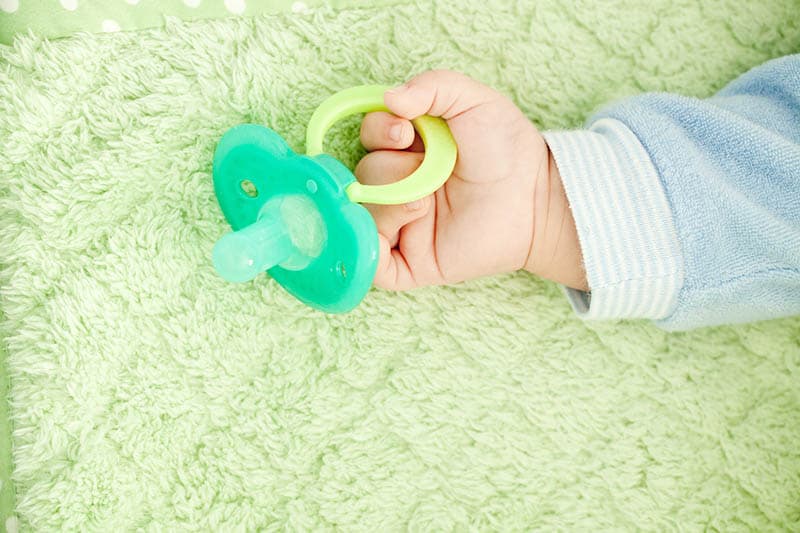Since starting to breastfeed your baby you may have noticed that he’s begun to get a bit fussy and is having a hard time latching on to your nipple. This is what is called nipple confusion and it is a common occurrence. But how to fix nipple confusion?
Well, that question has several answers, ranging from different methods of reducing the effects of nipple confusion to outright prevention of it altogether, depending on if it’s occured yet or not.
I had some issues with it when I had my first child because I had no idea that it was a thing initially, but I’ve learned through practice.
It’s not that big of a problem, it’s just annoying once it happens and detracts from the bonding time you normally get to have with your little one.
While it can take a bit of time to remedy, your baby will return back to his regular pattern soon enough, just be patient and try your best to expedite the process by using some of these steps.
The 8 Steps To Take When Looking At How To Fix Nipple Confusion
A preface before we start – as effective as these steps may be, the level of their positive effect differs based on what the reason for the nipple confusion may be in the first place.
Thankfully they all make the potential source easy enough to discern once you read through them.
1. Stop using the baby bottle/pacifier for a while

The source of a breast refusal problem most often comes from starting the baby on bottled milk too quickly or too often, allowing them to get used to the way the silicone bottle teat feels in their mouth instead of their mother’s bosom.
This, in turn, leads to the baby having a hard time returning to the natural source.
The main reason for this is because the bottle may offer a fast flow of milk, faster than your breast, and it’s only natural for them to want something that works better for them.
The way to solve this is to try hand expressing your milk to increase the flow for a bit, so your baby can adjust to your speed once again.
In the meantime, you should ditch the old bottle and get one that has a slow-flow nipple, designed to better simulate the flow of your teat so you won’t have to hand express milk all the time, as this could lead to soreness.
It’s a plus if you can get a silicone bottle nipple shaped just like the real thing – my personal suggestion would be a Tommee Tippee’s Closer to Nature Baby Bottle, a bottle that was personally recommended to me when I first had similar issues.
I can’t say I’ve had many problems since, but they did rear their ugly head sometimes. But, that wasn’t because of the bottle, it was for another reason.
2. You might not be expressing enough milk

There were times where my milk flow just wasn’t enough at times.
Sometimes it was the stress and concern about whether my darling son was ever going to continue breastfeeding, sometimes because I was worried that I was just stuck with the bottle, and sometimes I simply wasn’t eating well enough.
Sometimes it was all three of these reasons.
Stress can influence our bodily functions greatly, although one should try one’s best to not let it, especially you new moms.
It will murder your productivity as well as your milk production, transferring some of that stress over to your baby.
This is never a healthy thing and is definitely something they don’t need this early in their lives.
To combat this, try some methods of relaxation.
Teas, yoga, or anything that helps keep you happy and satisfied.
Proper sleep is important too – and definitely something you might struggle with when you have a newborn.
Try your best to maintain it as close to 6 hours as possible, if not the full 8.
Until your milk flow is back in order, you’ll have to try doing manual breast compressions to express a bit more breast milk during feeding time.
The process is as simple as it sounds: you wait until you see your baby start to get a little worried about the flow of milk slowing down and then you slowly begin squeezing the breast while cupping it, allowing the milk to flow once more.
Do make sure to keep the compressions gentle so it doesn’t start to hurt and don’t overwhelm your baby or give them higher expectations about your milk production than you’re able to meet later on.
Also, try to alternate between breasts to give one time to rest while the other one works its magic.
Hopefully, your milk supply will be restored quickly so you can go back to a normal routine sooner rather than later, leaving less room for more panic to set in.
3. Calm the baby down

Sometimes it might not be an issue with giving the baby too much time with the bottle nor your milk flow being slow, sometimes the baby might just be distressed.
The main way to solve this is by trying to keep breastfeeding time as pleasant as you can to try and keep the baby calm.
This means nursing in a quiet room with no distractions to pull the baby’s attention away from the task at hand.
You should find a comfortable position for both you and your child to minimize any unpleasantness.
Some light and relaxing music always helps to get in the mood and help the letdown reflex kick in, at least it did for me.
Make sure to increase the area where the baby interacts with you.
Lots of skin-to-skin contact is highly encouraged to keep them calm as the warmth coming from you is something the baby is accustomed to given that they were surrounded by it for 9 months.
This is key to maintaining a healthy breastfeeding relationship and is the best go-to for nursing moms struggling with the dilemma of how to fix nipple confusion.
It’s what keeps them coming back even if they’ve gotten more used to bottle feeding with an artificial nipple.
This doesn’t just mean keeping them nestled on you though.
You can use your free hand to rub your baby’s soft back gently – nothing too intense that could serve as a distraction, but simply a calming tool.
You can also try conversing with them in a soft tone of voice or just humming along to a tune that’s playing (or just one from your head).
Maybe tell them a story, almost as if you’re trying to put them to sleep.
Employing the earlier technique of expressing your milk through a bit of compression can work to sway their opinion faster, though make sure to keep it at a somewhat even and reasonable pace.
And most important of all, be patient.
The problem will not go away instantly, but perseverance will lead to your baby once again preferring the natural source of mother’s milk over the alternatives, leading to a satisfied and breastfed baby.
4. Change your pacifiers

This is something that ties into the bottle nipple issue as well.
The unnatural shape of the artificial nipple provided by pacifiers and baby bottles is the leading cause of nipple confusion so it pays to have both mimic the softness and shape of the original.
I’ve already recommended a bottle, but as for the pacifier I believe that Nanobébé pacifiers are the optimal choice.
At least they were for my first child when I had these issues with her, but it mostly boils down to what shape fits your baby’s mouth the best.
5. Fix any latching issues

Another rather common approach on how to fix nipple confusion is to correct the position in which you breastfeed your baby in the first place.
A slough of breastfeeding problems appear from a poor breastfeeding position.
The way to fix it is by, as mentioned earlier, keeping the baby’s body close to yours.
Make sure you leave some space for their head to move around so they can adjust their mouth to your nipple.
The most common position for the head is to keep the nose close to the nipple so the baby has to open wide to latch on properly.
This is why the wiggle room is important, to allow for enough room for the lower jaw to adjust.
This method mimics the sometimes wider shape of the bottle, making the transition back a lot easier and giving the baby a good spot to latch on.
Once the baby latches on to the nipple, you’re good to go with your regular process.
Another thing you can try is to adjust the shape of the nipple to the shape of the baby’s mouth, though that only has a minor positive effect toward the whole ordeal and shouldn’t affect the comfort of it too much.
6. Deal with breast engorgement

Another potential problem that you might encounter is occasional bouts of breast engorgement.
This is a problem opposite to low milk production.
A problem where you, in fact, produce too much milk, making your breasts too firm and your nipple too flat for your baby to latch on to, causing distress in the baby due to not being able to drain enough milk out of it to sate their hunger.
It also leads to sore and cracked nipples and pain in your chest area in general, since they essentially act as bloated up balloons and it’s necessary for you to ‘deflate’ them a bit when this happens (or just the affected breast if it’s only one).
If you’re going to feed your baby, you might want to try expressing a bit of milk out of it first to let the nipple adjust first and soften the rest of your breast up so the baby can rest on it properly.
That, or you can get a breast pump and slowly siphon the excess milk off into bottles for future storage and use – no need to let it all go to waste after all.
If you do use a pump though, you might want to adjust the settings to minimum suction to lower any potential discomfort a higher power setting might cause due to being engorged in the first place.
7. Speak to a lactation consultant

If you’re having trouble getting started in the first place, due to being a new mom with very little experience of breastfeeding your little one, you might want to seek out your local lactation consultant and ask them for proper advice.
As much information as mommy blogs and the internet as a whole can give out, it’s still rather basic and based around our own experiences.
We’re there to cover the basic stuff around the topics that us mamas represent, but nothing beats a professional when you want to know a bit more about the tips and tricks to any specific activity or the problems that you or your child might encounter.
8. Know when to introduce the bottle properly

You can keep your baby breastfed for basically the entirety of maternity leave without the need to ever use a baby bottle unless you’re really tired or sore, your breast simply isn’t producing enough milk or simply to get rid of that excess that we talked about that might happen during engorgement.
You can use the bottle sometimes, but it’s best to wait for at least the end of maternity leave.
I’d suggest a longer period, but sadly, the maternity leave here in the US is only a measly, unpaid 12 weeks.
This is what makes many moms leave their jobs and decide to become stay-at-home moms.
They’d rather devote their full attention to their kids than come home too tired from work to do much of anything.
Personally, compared to other countries, that amount of time is a joke and the main reason why nipple confusion is so prevalent in our country, as the baby is forced to start using the bottle so frequently so early.
If your workplace allows for longer periods of maternity leave, hats off to you and congratulations on finding that opportunity because it is rare, especially if it’s paid.
In Conclusion
Nipple confusion is a widespread, but thankfully temporary problem that plagues many babies worldwide, especially firstborns who have less experienced moms.
Luckily, it’s only a minor annoyance and has simple and easy ways of being resolved.
Speaking of which, I do hope that at least some of the methods I’ve laid out here manage to help you solve your nipple confusion issues and that you can get back to a happy baby who’s eager to suckle on their mother’s teat once again.
It caused me a fair bit of trouble with my baby at first and I wanted to prevent that from happening with your own kids.
Until next time, mamas!
Like this post? Please share or pin it for later. You can also stay in the loop and follow us on Facebook, Instagram or Pinterest.

We love honesty! Find Your Mom Tribe is an Amazon Associate and we earn from qualifying purchases through affiliate links at no extra cost to you. Please see our full Amazon Affiliate disclosure for more information.


Top List 20+ Nipple Confusion How To Fix 2022: Full Guide - Dream Cheeky
Friday 18th of November 2022
[…] Source: ? […]